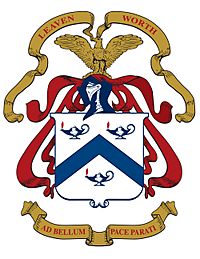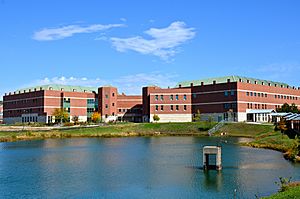United States Army Command and General Staff College facts for kids
Quick facts for kids The Command and General Staff College |
|
|---|---|

Fort Leavenworth, U.S. Army Combined Arms Center, and U.S. Army Command and General Staff College Device
|
|
| Active | 1881–present |
| Country | |
| Branch | |
| Garrison/HQ | Fort Leavenworth, Kansas |
| Motto(s) | Ad Bellum Pace Parati |
| Commanders | |
| Commandant | LTG Theodore D. Martin |
| Deputy Commandant | MG Donn H. Hill |
The United States Army Command and General Staff College (CGSC or, obsolete, USACGSC) at Fort Leavenworth, Kansas, is a graduate school for United States Army and sister service officers, interagency representatives, and international military officers. The college was established in 1881 by William Tecumseh Sherman as the School of Application for Infantry and Cavalry (later simply the Infantry and Cavalry School), a training school for infantry and cavalry officers. In 1907 it changed its title to the School of the Line. The curriculum expanded throughout World War I, World War II, the Korean War, and the Vietnam War and continues to adapt to include lessons learned from current conflicts.
In addition to the main campus at Fort Leavenworth, the college has satellite campuses at Fort Belvoir, Virginia; Fort Lee, Virginia; Fort Gordon, Georgia; and Redstone Arsenal, Alabama. The college also maintains a distance-learning modality for some of its instruction.
Contents
Mission statement
The United States Army Command and General Staff College (CGSC) educates and develops leaders for full spectrum joint, interagency and multinational operations; acts as lead agent for the Army's leader development program; and advances the art and science of the profession of arms in support of Army operational requirements.
Schools

The college consists of four schools: the Command and General Staff School, the School of Advanced Military Studies, the School for Command Preparation, and the School of Advanced Leadership and Tactics.
- Command and General Staff School (CGSS) provides Intermediate Level Education (ILE) for United States Army and sister service officers, interagency representatives, and international military officers. ILE is a ten-month graduate-level program; the curriculum includes instruction on leadership philosophy, military history, and the military planning and decision-making processes. There is one ILE class per year; starting in August and ending in June. About 1,200 US military and international officers make up the class. In addition to the ILE curriculum, a graduate masters program exists for students who may qualify to complete a thesis-level research paper and receive a Master of Military Arts and Sciences (M.M.A.S.) degree from the Command and General Staff College. The program is accredited by the Higher Learning Commission, the accrediting body for collegiate institutions in the midwestern United States. ILE students are normally mid-career field-grade officers preparing for battalion command or staff positions at the division, brigade, or battalion level. In addition to CGSS at Fort Leavenworth, the school operates satellite campuses at Fort Belvoir, Virginia; Fort Lee, Virginia; Fort Gordon, Georgia; and Redstone Arsenal, Alabama. Students at the satellite campuses complete the ILE Common Core, a condensed ninety-day program without the M.M.A.S. option, in lieu of the traditional ten-month program.
- School of Advanced Military Studies (SAMS) provides post-ILE instruction on complex military issues at the strategic and operational levels. Students who complete the curriculum receive a Master of Military Arts and Sciences degree and are then assigned as high-level military planners.
- School for Command Preparation (SCP) provides instruction for colonels, lieutenant colonels, and command sergeants major who have been selected for brigade or battalion command. Courses are normally three to four weeks and focus on special topics unique to assumption of command at the levels indicated.
- School of Advanced Leadership and Tactics (SALT) provides officer continuing education towards developing the Scholar-Warrior-Leader from first lieutenant to selection for major. The result is mastery of branch-specific technical and tactical skills, staff processes in battalions and brigades, direct leadership and command competencies, and initial broadening opportunities.
During World War I, the CGSC at Ft. Leavenworth was closed, from 1916 until 1920. Most of the school staff was sent to Langres, France, to open and conduct the Army General Staff College, which operated from November 1917 to December 1918. This compressed-curriculum school was needed to provide command and staff officers for the exponentially growing number of Army units; divisions, regiments, brigades, and battalions.
Master of Military Art and Science degree
The Command and General Staff College confers a Master of Military Art and Science professional degree to graduates of the School of Advanced Military Studies as well as graduates of the Command and General Staff School who complete a thesis-level research paper. The degree is accredited by the Higher Learning Commission for collegiate institutions in the midwestern United States.
Military art and science is an interdisciplinary field of study. It encompasses many academic disciplines insofar as they relate to war, peace, and the employment of military forces; they include established academic fields of study such as sociology, history, engineering, psychology, politics, geography, science, ethics, economics, anthropology, and others. It may also include other professional fields of practice such as medicine and the law insofar as they interact with the military or are applied to military matters. It provides intellectual and theoretical depth to the military profession and its practitioners. Thus, a large proportion of research in the field of military art and science is done to address practical problems faced by practitioners. Purely academic research, however, is also an integral part of the field and is essential to ensure its continued intellectual vitality. The results of scholarship and research in the field may be of interest and may be helpful to political leaders and policymakers, military officers, as well as to scholars and the interested public.
Military art generally deals with the human dimensions of war and military operations. Military art is generally subject to qualitative rather than quantitative investigation, although it does not exclude the use of quantitative methods when appropriate. It includes such areas as psychology, leadership, individual and collective behavior, culture, ethics, and problem-solving. History provides the context and depth for the study of military art. Military art also includes such specifically military subjects as strategy, operational art, and tactics.
Military science generally deals with the technical dimensions of war and military operations. Military science is generally subject to quantitative rather than qualitative investigation, although qualitative methodologies are used when appropriate. It includes such areas as the technological military applications and equipment made possible by the physical sciences, various engineering disciplines, industrial management, logistics, electronic simulations, communications technologies, and transportation technologies. Mathematics is an important tool in the practice of military science and associated disciplines. Specific military applications include gunnery and ballistics, materials science technology for soldier protection, transportation technologies, and communications technologies.
The interdisciplinary field of military art and science may be pictured as a "big umbrella" which encompasses other academic disciplines and fields of professional practice.
Notable people
Notable alumni
|
|
|
|
Notable foreign alumni
The college reports that 7,000 international students representing 155 countries have attended CGSC since 1894 and that more than 50 percent of CGSC International Military Student (IMS) graduates attain the rank of general.
- General Carlos Prats, Commander-in-Chief of the Army, Interior and Defense Minister, Vice President of the Republic of Chile.
- Minister of State General Mohammed F Abo Sak of Saudi Arabia
- Prime Minister and General Kriangsak Chamanan of Thailand
- General Alfredo M. Santos of the Philippines
- Lieutenant General Rafael Ileto (former Secretary of the Department of National Defense) of the Philippines
- Prime Minister and General Tran Thien Khiem of South Vietnam
- General Do Cao Tri of South Vietnam
- General Hau Pei-tsun of the Republic of China (Taiwan)
- President Paul Kagame of Rwanda
- General Katumba Wamala of Uganda
- Brigadier General Muhoozi Kainerugaba son of Ugandan president
- General Muhammad Zia-ul-Haq of Pakistan
- General Rahimuddin Khan of Pakistan
- General Jehangir Karamat of Pakistan
- General Ashfaq Parvez Kayani of Pakistan
- General Eiji Kimizuka of Japan
- General Hisham Jaber of Lebanon
- General Krishnaswamy Sundarji of Indian Army
- Prime Minister and Brigadier-General Lee Hsien Loong of Singapore
- General Dieudonné Kayembe Mbandakulu of the Democratic Republic of the Congo
- President Gaafar Nimeiry of Sudan
- Lt. Colonel Anastasio Somoza Portocarrero of the Guardia Nacional de Nicaragua
- General Nguyễn Hợp Đoàn of South Vietnam
- General Nguyễn Khánh of South Vietnam
- General Phạm Văn Đồng of South Vietnam
- Ministry/Chief of Army General Staff and General Ahmad Yani of Indonesia
- President and General Susilo Bambang Yudhoyono of Indonesia
- General Veljko Kadijević of Yugoslavia
- General Antonio Domingo Bussi of Argentina
- General Moeen U Ahmed of Bangladesh
- General Amer Khammash of Jordan
- General Arne Dagfin Dahl of Norway
- General Gustav Hägglund of Finland
- General Avigdor Kahalani of Israel
- Lieutenant General David Tevzadze of Georgia
- Major General Vladimer Chachibaia of Georgia
- Colonel Nikoloz Janjgava of Georgia
- General Moeen U Ahmed of Bangladesh
- Général d'armée René Imbot, Chief of Staff of the French Army, General Director of DGSE, France
- King Hamad bin Isa Al Khalifa of Bahrain
- General Abdulkadir Sheikh Dini of Somalia
- Colonel Ahmed Mohammed Ali of Egypt
- Lieutenant General Sean McCann of Ireland
- General Mahesh Senanayake of Sri Lanka
- General Bipin Rawat of India, Chief of Defence Staff
- Lieutenant General Mykhailo Zabrodskyi of Ukraine
Notable faculty and deputy commandants
- Robert Arter (Deputy Commandant 1977–79)
- Richard E. Cavazos (faculty 1970–71)
- Roger H.C. Donlon (1978–81)
- Frederick M. Franks Jr. (Deputy commandant 1985–87)
- Glenn K. Otis Deputy Chief of Staff 1976–78
- Colin Powell Deputy Commanding General of the Combined Arms Combat Development Activity (1982–83)
- Gordon R. Sullivan Deputy Commandant 1987–88
- Adna R. Chaffee Jr. 1919–20
- Clarence R. Huebner (1929–33)
- Walter Krueger (1901–12)
- Lucian Truscott 1934–40
Commandants
Since 1976, the commandant of the college has been a lieutenant general. David Petraeus was the commandant between 2005 and 2007, immediately before going to command the Multi-National Force – Iraq.
Photo gallery




